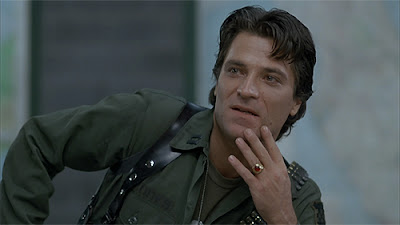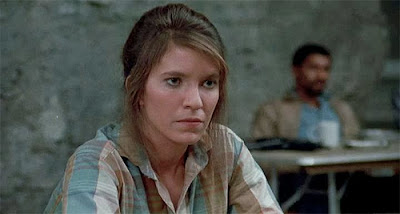DAY OF THE DEAD (1985)
With the market flooded with zombie movies following Dawn of the Dead, it's surprising that George A. Romero didn't decide to hold off and wait a full ten years before revitalising the genre one more time. Perhaps it would have been more warmly received if it wasn't competing with tongue-in-cheek fare like Demons and Return of the Living Dead. Maybe it was just the wrong year to release something like this, which is easy to say in retrospect. Times had changed and fun was back in vogue. Films from Amblin and John Hughes were now all the rage. But refusing to read the room like any true pioneer, George went into darker territory and refused to include any glib nonsense. It's still another horror classic in its own way.
The outcome is grim and often stomach churning. Digestive systems were torn out in the previous two movies of course, but there's a nastier vibe to it all here. The tone is darker, and so is all the blood. Tom Savini's mixture (using Dick Smith's recipe) is far more realistic looking. The comic book tomato soup from Dawn of the Dead is long gone. The zombies feel truly rotten, and there are less simplistic face paint effects, and more appliances. The opening shot sums all of this up pretty well, as the sunshine of Miami is blocked out by the silhouette of a chap-less ghoul. The daylight warmth of summer is cursed, and the last remaining survivors are forced into a subterranean base. But where else could the story go when the dead now outnumber the living?
It's not a hopeful situation, and there's still the recurring problem of human egos and personality clashes. Like the conflicts in various 1950s sci-fi yarns, this is another example of military might versus scientific thoughtfulness. With a handful of neutral technicians just to make things awkward. But this isn't The Thing From Another World, and the army's involvement only causes problems. There's no way to fight the plague, causing the already unstable soldiers involved to become increasingly hostile. There's a distinct rot in the silo they've become trapped in, and it's not just because of all the cadavers being used in their laboratory. The lesson eventually becomes knowing when to move on and simply live, which only a few characters manage to learn.
Foreshadowing Aliens one year later, Dr. Sarah Bowman (Lori Cardille) is stuck trying to keep it together as Captain Rhodes (Joe Pilato) and his juvenile comrades start to crawl the walls. It's hardly a parental storyline, but it does include a few twisted notions about how to discipline child-like adults - living and dead. These aren't complex and well drawn characters. The cast includes an alcoholic Irish radio operator (Jarlath Conroy) and a Caribbean pilot (Terry Alexander) who just wants to fly away and chill out. But like Aliens, having a series of larger than life personalities makes the ensemble work. Some of them only have limited screen-time, but they're all pretty memorable, if not likeable, for different reasons.
Sarah is super level headed where necessary, and Rhodes is a super scum-bag as often as possible. It's a stark and grey affair in a lot scenes, so colourful characters are a must. Not everyone is nuanced, but there are signs of them breaking that make it all too human at times. They all deal with the increasing pressure in different ways; some that are more understandable than others. Privates Steel (Gary Howard Klar) and Rickles (Ralph Marrero) act like hideous children to cope, although perhaps they were always this way. At the opposite end of the spectrum Dr. Logan (Richard Liberty) seems to think only about his work, although his apparent Hippocratic empathy hides another kind of decay.
Dawn of the Dead was an adventurous fantasy at times, before that decay of reality set in. This time around the putrefaction is already established. At times it's just back to the basics of 1968 in a certain way. The claustrophobia and bickering has just been updated for a new decade. Human beings are the real problem once again, and George Romero is toying with the idea that the undead are the sympathetic characters. Logan's new pet Bub (Sherman Howard) is the most obvious symbol of this change in approach, but there are others throughout. Within the confines of this base it's clear that certain traits are only exhibited by one side - some are brain-dead by choice. Why rebuild if this is what their brightest and best have to offer?
It's a nihilistic outlook, but not every film about zombies has to involve Muzak and pie gags. There's still a huge amount of scenery chewing to enjoy, and John Harrison's score is actually pretty upbeat. The message might be about letting go and seeing a hopeless situation for what it is. There may be too much yelling at times, and it's often a relentless experience. But there is a lot of food for thought included, particularly on repeat viewings. It's a recommended conclusion to a trilogy in which all the instalments have similar ingredients, but different flavours. Just don't try eating too much before sitting through some of cinema's most gruelling zombie effects.
4/5
BONUS REVIEW
THE CRAZIES (1973)
Since there were only ever three films in Romero's zombie back-catalogue let's take a look at a film with a less clear message. In fact there's not much in the way of well defined elements at all. It's a messy affair, despite the overarching theme of incompetent bureaucracy and over zealous military action. The narrative is meandering and the characters aren't well defined. It has a low budget charm but it's lacking charisma, particularly in the two romantic leads. Even the central threat, the accidental release of a biological agent in a small town, isn't explored in much real detail. It's an intentionally chaotic tale, which has some advantages and some drawbacks. But it's still an interesting entry to his series of anti-authority stories.
The threat of a nuclear strike in rural Pennsylvania grows due to a virus code-named Trixie, recently released during a plane crash. The locals start to lose their minds in a variety of ways, including murdering each other and developing incestuous urges. In some ways this has the vibe of a precursor to Dawn of the Dead. I'd also well worth watching David Cronenberg's Rabid for something in a similar vein. There's a lot of mystery disease madness, and a lot of rural 1970s fashion to be enjoyed. Town nurse Judy (Lane Carroll) and her veteran boyfriend David (Will McMillan) are the doomed lovers a the centre of it all this time, but they don't have enough chemistry.
With martial law in effect they join various locals and try to escape a growing number of faceless troops. There are many scenes of germ fuelled insanity, but there are also many officers and scientists talking on phones. It's less about the people, and more about the lack of communication
between government agencies as everything falls apart. Which is a scathing and perhaps evergreen message, but not something that's ever really that compelling. Romero sometimes claimed that the social themes in his earlier films weren't intended, but it's hard to believe him in this case. It's very simple, and it's very bleak, but it's never structured well enough to be an engrossing affair. Still, fans of the director will get a kick out of seeing a few familiar faces in earlier roles.
3/5



